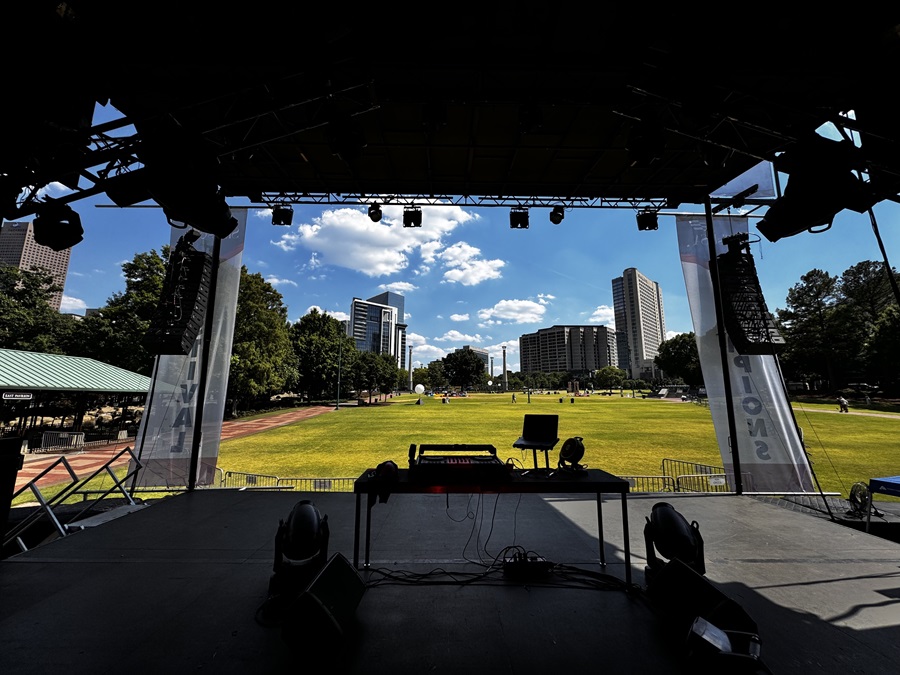Stage Truss Rentals Are the Unsung Heroes of Any Production
Imagine planning a big event—lights flashing, speakers blasting, screens displaying incredible visuals. With those things in mind, your first thoughts will be to focus on lighting and AV rentals for your upcoming event.
What you might not think about but absolutely need are the stage truss rentals that make all of that possible. Stage trussing and rigging are the unsung heroes of event production. They form the strong foundation that holds everything overhead, from audio equipment to LED screens, and make the entire event come alive.
In this blog, we’ll break down why trussing and rigging are so important for your event and why getting these elements right matters just as much as your audio and lighting plans. We’ll also showcase how Technical Elements approaches complex rigging requirements to keep everything running smoothly and safely every single time.
SEE MORE: Don’t Let Stage Design Be an Afterthought
What Is Stage Trussing and Rigging?
Truss and rigging support all the overhead equipment, including lights, audio, LED screens, and scenic elements. Without a solid truss structure and well-planned rigging, those impressive visuals and clear sound wouldn’t happen.
Rigging touches every aspect of your event production. The lighting crew depends on it to position lights perfectly. The audio team relies on it to hang speakers in the right spot for the best sound coverage. The video team counts on it to mount screens in a way that engages every attendee. Each department needs the rigging to work flawlessly so they can do their jobs effectively.
What Is the Typical Process for Stage Rigging?
It all starts with detailed planning, and a huge part of that planning comes down to creating the drawings and schematics. The drawings include the truss layout, motor locations, venue details such as walls, and beams or installed rigging points. These drawings also include the reference point—usually the downstage center mark (DSC)—along with dimensions for the motors and the stage, plus elevation drawings that give the on-site team a solid reference for what they’re building.
Once the schematics are ready, they undergo a review and approval phase, which varies depending on the type of event:
- Ballrooms: We work with the in-house design team to stay within the ballroom’s engineering specs. These specs are often much lower than those for bigger spaces like arenas, which means adjustments are necessary to stay within the venue’s limits.
- Arenas: We run our design through the arena’s head rigger, who signs off or gives us a list of changes. The venue’s head rigger knows the space inside and out, and their insights are crucial for ensuring everything will work smoothly during load-in.
- Outdoors: Outdoor shows have their own rules and guidelines. For Stageline stages, for example, there’s a lot of back-and-forth to get things signed off by a lead Stageline tech.
What Are Some of the Biggest Challenges?
The biggest challenge in rigging comes down to adapting to different event spaces and their unique constraints. Not all venues are created equal, and the requirements vary dramatically depending on the space. Below are some examples:
Hotel Ballrooms: They aren’t the most friendly venues when it comes to adding heavy AV equipment. You have to get creative with distributing the load since ceiling load limits are much lower than in other venues. Sometimes, this means ground stacking speakers or LED walls rather than hanging them from the ceiling or distributing weight across multiple rigging points to avoid putting too much strain on one part of the structure.
Arena Shows: The challenge shifts to managing large amounts of equipment and coordinating with the venue’s rigging team to find the best setup. Arenas are designed for heavy loads, but they also have specific regulations and requirements that must be followed.
Outdoor Events: When a stage needs to be set up in the elements, the rigging team often follows strict guidelines to ensure security despite changing weather conditions. Each outdoor show requires adapting to the conditions and space available, which means careful planning and sometimes adjusting on the fly to keep everything safe.
Need expert help with stage trussing and rigging for your next event? Our team at Technical Elements is ready to support you. Call us today or fill out our contact form to get started.

